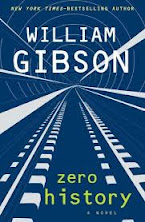Confession time. Gibson has written three, loosely linked “trilogies” of novels to date, and may be in the middle of a fourth… To date, the third novel of each trilogy I’ve read has been the weakest of the three—still good, but not as strong as the two novels that preceded them. In each I’ve felt Gibson spread himself too thin, tried to converge too disparate a number of storylines, resulting in each getting less of the author’s trademark focus to develop and evolve them. Question is: will Gibson adopt the same approach in Zero History (2010), third and concluding volume to the Blue Ant trilogy?
Like all the trilogies prior, Zero History features the return of some characters from prior novels, but not all. Hollis Henry, former rock-n-roller now journalist that first appeared in Spook Country, returns in Zero History. Fully in the employ of Bigend at Blue Ant, in the early going she is asked to find the source of a pair of rare denim jeans that have an underground clique popularity. Milgrim from Spook Country is now getting over his pill addiction after some experimental surgery, and is likewise in the employ of Bigend, helping him track down and survey obscure articles of fashion. When people within Bigend’s own employ start to display signs of internal espoionage, the wheels of Hollis and Milgrim’s missions start to unravel.
Zero History is quietly Gibson’s most absurdist novel. Tone, presentation, plotting—all parallel the two previous novels. But content is of a different nature—and it takes time to arrive at the realization given the roll out hints at deeper, darker things than the ridiculousness at which it arrives. It’s important to point out the absurdity I anything but accidental. Gibson, as always, is fascinated by the extent and lengths humans go down various roads that to the layman seem unimportant or even illogical. In the case of Zero History the key is fashion, but the point at which the story arrives is far more serious than appearances—and highly engaging for it. Real world stories of killing for a new pair of Air Jordans is just the tip of the book’s iceberg.
If the onslaught of materials and textures, objects color names bothered you from the previous novels, Zero History does not take its foot off the accelerator. While it’s possible to notice the significance these things take on in the narrative as a result, more importantly is to ask why, particularly in the manner it complements the themes of humanity and materialism.
To go back to the question in the introduction of this review, no, Zero History does not follow the same pattern of the books which closed Gibson’s prior two trilogies. It does not open the doors wider to a broader set of characters or settings, or seek to spread itself a larger canvas. It remains as tight and focused, if not slightly more so than the prior two novels. After taking a couple steps backs, however, one has to wonder how Gibson was able to derive as much material and stoy as he did from the premise, and the conclusion to those thoughts is not always in the book’s favor. All that being said, Zero History caps what is Gibson’s crowning achievement to date: the realism and social commentary inherent to the Blue Ant trilogy, making it one of the early 21st century’s must reads.


No comments:
Post a Comment